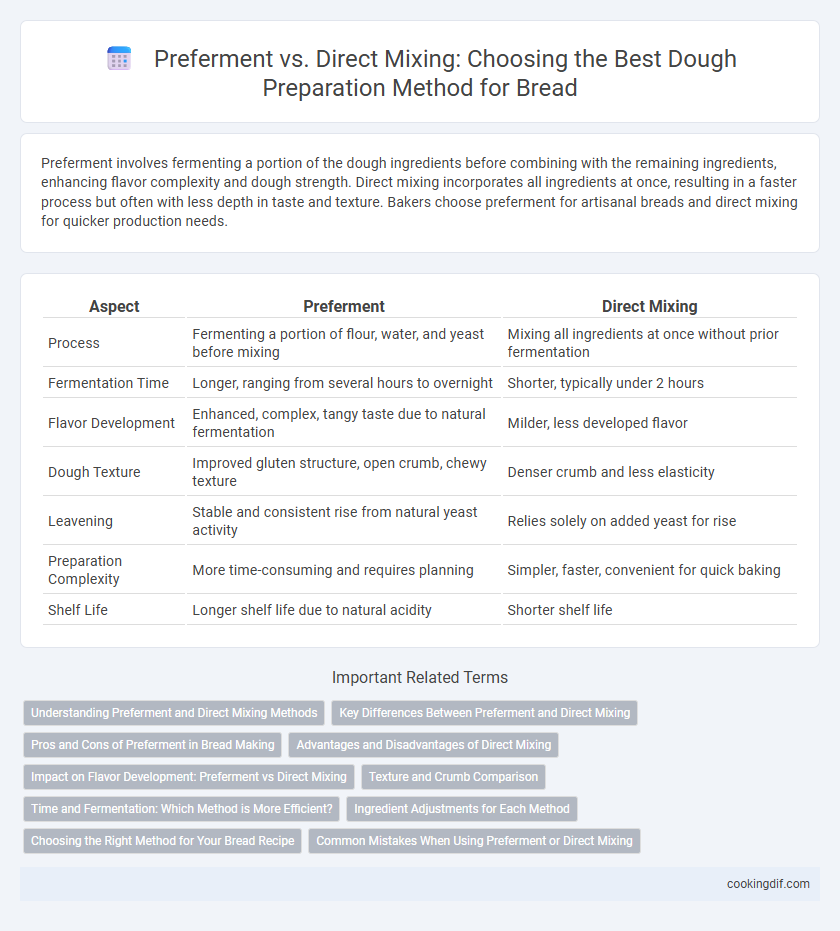Preferment involves fermenting a portion of the dough ingredients before combining with the remaining ingredients, enhancing flavor complexity and dough strength. Direct mixing incorporates all ingredients at once, resulting in a faster process but often with less depth in taste and texture. Bakers choose preferment for artisanal breads and direct mixing for quicker production needs.
Table of Comparison
| Aspect | Preferment | Direct Mixing |
|---|---|---|
| Process | Fermenting a portion of flour, water, and yeast before mixing | Mixing all ingredients at once without prior fermentation |
| Fermentation Time | Longer, ranging from several hours to overnight | Shorter, typically under 2 hours |
| Flavor Development | Enhanced, complex, tangy taste due to natural fermentation | Milder, less developed flavor |
| Dough Texture | Improved gluten structure, open crumb, chewy texture | Denser crumb and less elasticity |
| Leavening | Stable and consistent rise from natural yeast activity | Relies solely on added yeast for rise |
| Preparation Complexity | More time-consuming and requires planning | Simpler, faster, convenient for quick baking |
| Shelf Life | Longer shelf life due to natural acidity | Shorter shelf life |
Understanding Preferment and Direct Mixing Methods
Preferment involves fermenting a portion of the dough ingredients before mixing the final dough, enhancing flavor complexity and improving crumb texture through extended yeast activity. Direct mixing combines all ingredients simultaneously, resulting in a faster process but often yielding less developed flavors and a denser bread structure. Choosing preferment methods like poolish or sourdough starter allows for superior aroma and shelf life, while direct mixing suits quick production and consistent results.
Key Differences Between Preferment and Direct Mixing
Preferment involves fermenting a portion of the dough ingredients before final mixing, enhancing flavor complexity and dough strength through extended fermentation and yeast activity. Direct mixing combines all ingredients at once, resulting in faster preparation but less developed flavor and texture. Key differences include fermentation time, flavor development, and dough extensibility, with preferment offering improved taste and aroma due to longer yeast fermentation.
Pros and Cons of Preferment in Bread Making
Preferment in bread making enhances flavor complexity and improves dough fermentation through natural yeast activity, resulting in better texture and crust development. It requires longer preparation time and careful temperature control, which may not suit rushed baking schedules. However, the extended fermentation reduces the need for additives and can increase bread shelf life by improving crumb structure.
Advantages and Disadvantages of Direct Mixing
Direct mixing accelerates the dough preparation process by combining all ingredients at once, which saves time and reduces labor costs. However, it may sacrifice flavor complexity and fermentation development compared to preferment methods, potentially resulting in less aromatic and textured bread. This technique is advantageous for commercial bakeries requiring fast production but may compromise the artisanal quality favored in traditional bread making.
Impact on Flavor Development: Preferment vs Direct Mixing
Preferment methods, such as poolish or biga, enhance flavor development by allowing yeast fermentation to produce complex organic acids and esters, resulting in a richer, tangier taste compared to direct mixing. Direct mixing combines all ingredients at once, leading to a faster rise but often producing a more neutral, less developed flavor profile. Bread made with preferment exhibits improved aroma, crust coloration, and depth of flavor due to extended fermentation and enzymatic activity.
Texture and Crumb Comparison
Preferment methods like poolish or sponge enhance dough texture by promoting gluten development and fermentation, resulting in a more open, airy crumb with complex flavor profiles. Direct mixing produces a tighter, denser crumb due to shorter fermentation and less enzymatic activity, often leading to a firmer texture. Bakers seeking a light, chewy crumb with superior flavor typically prefer preferment over direct mixing techniques.
Time and Fermentation: Which Method is More Efficient?
Preferment involves a longer fermentation time that enhances flavor and dough strength by allowing wild yeast and bacteria to develop before final mixing, making it more efficient for complex, rich bread profiles. Direct mixing combines all ingredients at once, significantly reducing preparation time but often sacrificing the depth of flavor and fermentation benefits. For efficiency in time-sensitive baking, direct mixing is faster; however, preferment yields superior fermentation quality that justifies the extended timeline.
Ingredient Adjustments for Each Method
Preferment dough preparation requires reducing yeast and water quantities in the final mix since fermentation occurs during the preferment phase, enhancing flavor and dough strength. Direct mixing involves combining all ingredients at once, necessitating precise yeast levels to ensure proper fermentation and rise within a shorter timeframe. Adjusting ingredient hydration and yeast proportion based on the method optimizes dough texture, fermentation speed, and final bread quality.
Choosing the Right Method for Your Bread Recipe
Preferment methods, such as poolish or biga, enhance flavor development and improve dough texture by allowing yeast fermentation before mixing, resulting in more complex and aromatic bread. Direct mixing is faster and simpler, combining all ingredients at once, ideal for quick bread recipes or when time constraints exist. Selecting the right dough preparation technique depends on desired crust characteristics, flavor depth, and available preparation time for optimal bread quality.
Common Mistakes When Using Preferment or Direct Mixing
Common mistakes when using preferment include underestimating fermentation times, leading to insufficient flavor development and poor dough strength. In direct mixing, errors often involve improper yeast amount or inadequate hydration, resulting in dense texture and uneven crumb. Both methods require precise temperature control and timing to avoid issues like over-fermentation or weak gluten networks.
Preferment vs Direct Mixing for dough preparation Infographic

 cookingdif.com
cookingdif.com